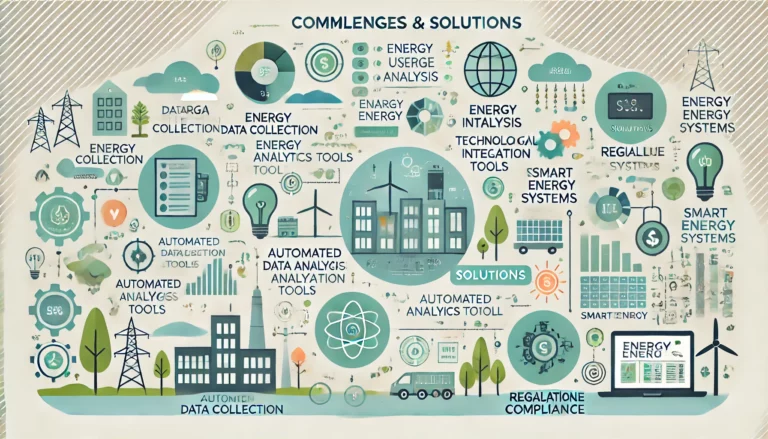Energy Audit for Sustainable Energy
Conducting an energy audit is a crucial step for organizations and homeowners committed to sustainability. By assessing energy consumption and identifying areas for improvement, an energy audit can significantly reduce energy costs and environmental impact. In this guide, we’ll walk you through the key steps in conducting an energy audit for sustainable energy, offering practical tips and insights along the way.
Understanding the Importance of an Energy Audit
Energy audits are essential for identifying inefficiencies and opportunities for energy savings. They help organizations and individuals make informed decisions about energy use, contributing to a more sustainable future. Energy audits can lead to significant cost savings, reduce greenhouse gas emissions, and enhance the overall efficiency of operations.
Types of Energy Audits
Before diving into the steps, it’s essential to understand the different types of energy audits available:
- Preliminary Energy Audit: A basic overview to identify obvious energy waste areas.
- Detailed Energy Audit: An in-depth analysis that includes a comprehensive review of energy usage, potential savings, and specific recommendations.
- Investment-Grade Audit: A thorough audit often used for securing financing for energy efficiency projects.
Step-by-Step Guide to Conducting an Energy Audit
1. Define the Scope and Objectives
The first step in any energy audit is to define the scope and objectives. This involves determining the areas to be audited and the goals you aim to achieve, such as reducing energy consumption, lowering costs, or minimizing environmental impact. Clear objectives help guide the audit process and ensure that the outcomes are aligned with your sustainability goals.
2. Gather Historical Energy Data
Collecting historical energy data is crucial for understanding past consumption patterns and identifying trends. This data includes:
- Utility bills: Gather at least 12 months of utility bills to analyze consumption patterns and costs.
- Energy use records: Review records of energy use in different departments or areas.
Historical data provides a baseline against which future improvements can be measured.
3. Conduct a Site Walkthrough
A site walkthrough is a visual inspection of the facility to identify areas of energy waste and opportunities for improvement. During the walkthrough, focus on:
- Lighting systems: Check for outdated or inefficient lighting fixtures.
- HVAC systems: Inspect heating, ventilation, and air conditioning systems for inefficiencies.
- Building envelope: Look for gaps, cracks, and insulation issues that may cause energy loss.
4. Use Diagnostic Tools
To gather more precise data, use diagnostic tools such as:
- Thermal imaging cameras: Identify heat loss and insulation issues.
- Power meters: Measure the energy consumption of specific equipment.
- Airflow meters: Assess the efficiency of HVAC systems.
These tools provide detailed insights into energy use and inefficiencies.
5. Analyze Energy Consumption
With the data collected, analyze the energy consumption patterns. Look for:
- Peak demand periods: Identify times when energy use is highest.
- Inefficient equipment: Pinpoint equipment that consumes excessive energy.
- Behavioral patterns: Understand how human behavior impacts energy use.
This analysis helps identify areas with the most significant potential for energy savings.
6. Identify Energy-Saving Opportunities
Based on your analysis, identify specific energy-saving opportunities. These may include:
- Upgrading lighting systems: Replace incandescent bulbs with energy-efficient LEDs.
- Improving HVAC systems: Implement regular maintenance and consider upgrading to more efficient models.
- Enhancing insulation: Seal gaps and improve insulation in walls, roofs, and floors.
Create a list of recommended actions, prioritizing those with the highest impact.
7. Develop an Action Plan
An effective energy audit concludes with a detailed action plan. This plan should include:
- Recommended actions: List all identified energy-saving opportunities.
- Estimated costs: Provide cost estimates for each recommendation.
- Expected savings: Estimate the potential energy and cost savings.
- Implementation timeline: Outline a timeline for implementing each recommendation.
8. Implement and Monitor
Implement the recommended actions according to your action plan. It’s essential to monitor the results to ensure that the anticipated savings are realized. Use energy monitoring tools to track progress and make adjustments as needed.
9. Review and Update
Energy efficiency is an ongoing process. Regularly review and update your energy audit to incorporate new technologies, practices, and improvements. Continuous monitoring and updating ensure sustained energy savings and environmental benefits.
Boost Your Sustainable Energy Efforts
Implementing the key steps in conducting an energy audit for sustainable energy can significantly enhance your sustainability efforts. By following a structured approach, you can identify inefficiencies, reduce energy consumption, and lower costs. Conducting an energy audit not only benefits the environment but also improves your bottom line. Stay committed to sustainability by regularly reviewing and updating your energy practices. This proactive approach will ensure long-term energy savings and contribute to a greener future.
Benefits of Conducting an Energy Audit
Here are some key benefits of conducting an energy audit:
- Cost Savings: Identify and eliminate energy waste, leading to lower utility bills.
- Environmental Impact: Reduce greenhouse gas emissions and minimize your carbon footprint.
- Enhanced Efficiency: Improve the efficiency of systems and equipment, leading to better performance.
- Regulatory Compliance: Ensure compliance with energy regulations and standards.
- Informed Decision-Making: Make data-driven decisions about energy use and investments.
Conclusion
Conducting an energy audit is a vital step towards achieving sustainable energy goals. By understanding the process and following the key steps outlined in this guide, you can make significant strides in improving energy efficiency and reducing environmental impact. Whether you’re a business owner, facility manager, or homeowner, conducting an energy audit is an investment in a more sustainable and cost-effective future.
For more information on sustainable energy practices and energy audits, feel free to reach out to our team of experts at BobbingInPetroleum. We’re here to help you every step of the way on your journey towards sustainability.
Frequently Asked Questions
Q: What is the primary purpose of an energy audit?
A: The primary purpose of an energy audit is to assess energy consumption, identify inefficiencies, and recommend measures to improve energy efficiency and reduce costs.
Q: How often should energy audits be conducted?
A: Energy audits should be conducted regularly, typically every 1-3 years, depending on the size and complexity of the facility and changes in energy use patterns.
Q: Can an energy audit help in achieving sustainability goals?
A: Yes, an energy audit is a critical tool in identifying and implementing energy-saving measures that contribute to sustainability goals and reduce environmental impact.
By following these steps and leveraging the insights gained from an energy audit, you can significantly enhance your energy efficiency and sustainability efforts. Remember, the path to a sustainable future starts with understanding and optimizing your energy use.




